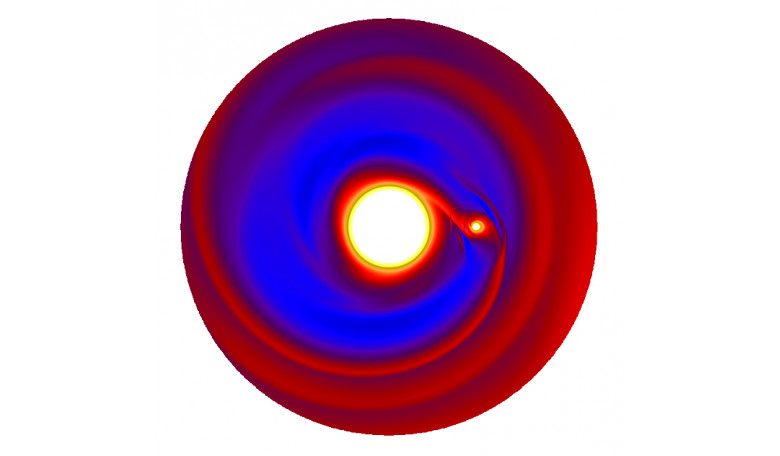The formation of gas giants such as Jupiter and Saturn has been a long standing problem in astronomy, now, with the aid of Europe's fastest supercomputer at CSCS and nine months running time on hundreds to several thousands of computing cores, researchers show that a planets temperature could be the giveaway as to how they evolved.
At present there are two main theories as to how gaseous giant planets could be born, either via ‘core-accretion,’ or from ‘disk instability.’ In the first scenario a solid core roughly ten times the size of the Earth is formed through the aggregation of smaller solids. This core is then massive enough to attract a significant amount of gas and keep hold of it.
In the second scenario, in a similar manner to how stars are formed, a massive gaseous disk around a young star collapses due to self-gravity of the gas-dust in the disk. During this process, spiral arms form with clumps inside which in turn collapse via their own gravity directly into a gaseous planet. In both cases, a disk forms around the gas-giants, called the circumplanetary disk, which will serve as a sort-of birth-nest for fledgling planets to form.
To ascertain which mechanism is the most likely, a team of Swiss astronomers used the Swiss National Supercomputing Centre (CSCS) in Lugano to simulate both scenarios. "We pushed our simulations to the limits in terms of the complexity of the physics added to the models," explains Judit Szulágyi, a professor at the University of Zürich, and lead author of two research papers detailing these studies, “and we achieved higher resolution than anybody before."
Through the simulations, it became apparent that one particular feature could be used to distinguish between the two theories - temperature. For the case of core accretion, the circumplanetary disk was heated to several hundreds of Kelvins whereas for the disk instability scenario, the gas in the planet's vicinity remained very cold, around 50 Kelvins. "The disk instability simulations are the first that can resolve the circumplanetary disk around multiple protoplanets, using tens of millions of resolution elements in the computational domain,” adds Lucio Mayer, one of the authors on the paper.
Luckily, this huge temperature difference should be easily observable. "When astronomers look into new forming planetary systems, just measuring the temperatures in the planet's vicinity will be enough to tell which formation mechanism built the given planet," explains Szulágyi. It was also previously thought that the mass of the circumplanetary disk that feeds the growing gas giant must be different for the two different formation scenarios, however, these simulations showed that this is not the case and that the masses of the disk are not so diverse after all.
If that wasn’t enough, then the results also showed that how scientists calculate the size of a newly born planet could be misleading. The computer simulations for the core accretion scenario showed that gas falling on the disk from the outside heats up and creates a very luminous shock front on the disk's upper layer. This alters the observational appearance of young, forming planets, sufficiently enough to overestimate a planet's mass by up to four times its actual size.
"When we see a luminous spot inside a circumplanetary disk, we cannot be sure whether we see the planet luminosity, or also the surrounding disk luminosity," says Szulágyi. "So maybe an observed planet has only the same mass as Saturn instead of some Jupiter masses.”
Despite these positive results, challenges still remain. Simulations of disk instability still do not cover a long enough timescale and it is possible that after the protoplanet has collapsed to the density of a planet like Jupiter, its disk will heat up more like it is undergoing core-accretion. It will take even longer computationally expensive simulations with a richer description of the physics to take scientists to the next step in understanding this problem.











